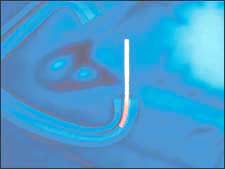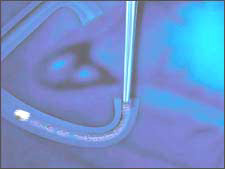Clinicians report favorable results with thermosensitive punctum plug
IRVINE, Calif. – Practitioners are reporting favorable experiences with Medennium Inc.’s SmartPlug, a new punctum plug available in only one size that can accommodate any patient’s punctum. No need for dilation, no hypersensitivity and ease of removal are some of the benefits clinicians shared with Primary Care Optometry News.
The thermodynamic punctal occlusion device is made from a heat-sensitive hydrophobic acrylic polymer material that changes its physical state between solid and soft gel when exposed to normal body temperature.
“I am overwhelmed with its ease of use and the fact that I now don’t have to inventory multiple punctum plug sizes,” said Stuart A. Gindoff, OD, MBA, FAAO, who practices in Sarasota, Fla.
|
Useful for nearly all dry eye patients
Nearly all patients with dry eye syndrome caused by a variety of conditions — including physical anomalies such as blepharoplasty or blepharitis, post-LASIK damage to the corneal nerves, contact lens wear and certain drugs such as birth control pills and hormone therapy — would benefit from the use of the SmartPlug, explained Dr. Gindoff.
“Major culprits such as Sjögren’s syndrome can make the patient miserable, with scratchy, red, gritty eyes,” he said. The SmartPlug handles these patients as well.
“I feel that plugs, in general, are very useful for a wide variety of dry eye,” said Paul S. Jensen, OD, from Renton, Wash. “I am also very excited about using plugs for glaucoma cases in which increased drug bioavailability is a concern.”
As far as treating dry eye due to insufficient tear production, excess drainage and poor tear quality, the SmartPlug works similar to other plugs on the market made of silicone. It completely plugs the canaliculus, keeping moisture in contact with the eyes and surrounding tissue for a greater length of time.
Data from the 120-patient U.S. clinical trial for SmartPlug demonstrated safety and effectiveness of the device to be equivalent to other marketed silicone punctum plug devices, according to Medennium.
Distinguishing characteristics
Though the dry eye treatment method is the same as with other plugs, hallmarks of the Medennium SmartPlug include having one size plug to fit all patients, no protruding head on the plug and no need to dilate during insertion in most cases.
“SmartPlug has completely circumvented one of the primary problems of other plugs, and that is sizing,” Dr. Jensen said. “Because SmartPlug tailors itself to each patient’s unique anatomy, it completely plugs the canaliculus with a single size.”
“I don’t have to dilate the punctum, and I don’t have to worry about corneal erosion from the head of a silicone plug rubbing against it,” Dr. Gindoff added.
Though Dr. Gindoff has not yet had a patient requiring dilation, he said he could imagine that it may be necessary to perform it in a patient with a very narrow punctal opening.
Inserting the plug
The SmartPlug is supplied by the company in sterile packages (that prevent premature changes if exposed to high temperatures) of two plugs in a thin, rigid state at 9 mm long and 0.4 mm in diameter. At this size, the plugs can be inserted into the patient’s punctum at room temperature. Only topical anesthesia is required, explained Jay V. Standish, vice president of sales and marketing for Medennium.
Once inside the punctum and in contact with body temperature, the rigid rod becomes a soft gel and shrinks in length and expands in width. At the maximum change, it is 2 mm long and 1 mm in diameter.
Medennium includes a special set of forceps in a starter pack for the SmartPlug, Mr. Standish said. The forceps have a groove that makes it easier to hold the SmartPlug during insertion. Dr. Gindoff recommends using the special forceps for the best results during the procedure.
Plug removal
Removal of the plugs can be performed by canalicular irrigation, which dislodges the material. Ordinarily, hydrophobic acrylic is a very sticky, tacky material, which helps the plugs stay in place by making them stick to the tissue in the punctum, Mr. Standish explained. But when you flush them with fluid, it makes them very slippery.
The plugs are a soft, clear gel at body temperature, so they are very difficult to detect or sense when flushed out. “We haven’t had an occasion of one getting stuck or any complications while removing them,” Mr. Standish said.
Dr. Jensen told Primary Care Optometry News: “To my knowledge, there have been no cases of stuck plugs or dacryocystitis with the SmartPlug. In fact, for those doctors who are concerned about the difficulty in removing plugs, I have found the SmartPlug to be amazingly easy to remove. Just a mild irrigation — sometimes as little as 1 cc of saline — is enough to remove it.”
No reports of hypersensitivity
Hydrophobic acrylic material is known to be completely inert within the body; therefore, even with the plug being completely below the surface of the skin, no reports of hypersensitivity or allergy have been made, Mr. Standish said.
“The most common contraindication for any plug is acute allergic conjunctivitis,” Dr. Jensen said. “SmartPlug is no exception. However, while I have had to remove quite a number of other types of plugs in cases where the patient had developed allergy to the plug material, I haven’t seen any material allergy cases with SmartPlug.”
Medennium is currently developing an IOL made from similar proprietary material, Mr. Standish said. The lens is in the development phase and could be in clinical trials within 2 years.
For Your Information:
- Stuart A. Gindoff, OD, MBA, FAAO, can be reached at Eye Center South, 5540 Bee Ridge Road, Sarasota, FL 34233; (941) 378-3937; Fax: (941) 378-1868; skipeye@comcast.net.
- Paul S. Jensen, OD, can be reached at Renton Vision Source, 112 Pelly Ave. N, Renton, WA 98055; (425) 255-2020; fax: (425) 255-2028; jensen@rentonvision.com. Neither Dr. Gindoff nor Dr. Jensen has a direct financial interest in the product mentioned in this article, nor are they paid consultants for the company mentioned.
- Jay V. Standish is vice president of sales and marketing at Medennium. He can be reached at Medennium Inc., 15350 Barranca Pkwy., Irvine, CA 92618; (949) 789-5388; fax: (949) 789-9032; Jstandish@Medennium.com.
- The SmartPlug is available from Medennium Inc., 15350 Barranca Pkwy., Irvine, CA 92618; (949) 789-9000 or (888) 727-6100; e-mail: info@medennium.com; Web site: www.medennium.com.




